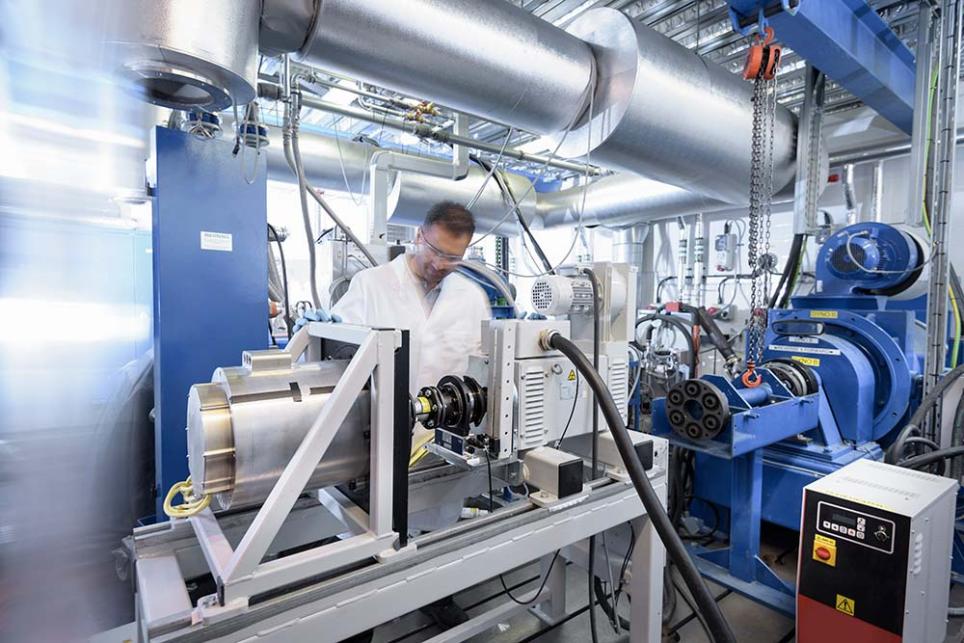Ongoing Research

The Electrochemical Safety Research Institute (ESRI) continuously researches innovations in technology to mitigate risks to safety and sustainability. Read more about our current projects below.
Pursuing a safe and efficient way to recycle Lithium-ion batteries with Rice University
ESRI is working with Prof. Pulickel Ajayan’s group at Rice University to develop and optimize -battery recycling to supplement our limited supply of raw materials and alleviate related economic, environmental, and ethical concerns. We are researching two different solutions to extract the valuable metals (nickel, cobalt, lithium, and manganese) from the cathode materials. We are comparing a state-of-the-art hydrometallurgical process using sulfuric acid for leaching to a process developed at Rice University that uses a less hazardous combination of reagents called a "deep eutectic solvent" which consists of a mixture of choline chloride and ethylene glycol.
Paving the way for green hydrogen energy with University of Houston
In an effort to realize the promise of green hydrogen technology, ESRI and University of Houston Assistant Professor Xiaonan Shan launched a collaborative research project in 2022 that aims to develop new materials and methods for producing hydrogen. The project also calls for characterizing the safety of hydrogen energy at all stages of production and while it is stored, transported, and used.
Characterization of particulates released during thermal runaway of lithium-ion modules with Southwest Research Institute
With the use of lithium-ion batteries on the rise, ESRI is working with Texas-based Southwest Research Institute to study the particulates emitted when those batteries fail and give rise to a process known as thermal runaway. The project measures the concentration, size, and mass of these particulates at both the single-cell and module levels, adding depth to research literature that has largely focused on characterizing the gases rather than the particulates released during thermal runaway.
Studies on the safety of fast charging in lithium-ion cells with Purdue University
Fast charge has become an area of interest due to the range anxiety from customers of electric vehicles (EVs). Charging at high currents may cause rapid degradation in cells and may lead to safety hazards. The goal of this study is to identify safety hazards and degradation pathways for different commercial cells that may result from fast charging. Not all lithium-ion cell designs and cell chemistries used in the EV batteries can accept fast charge in a safe manner. Electrochemical, morphological, and thermal properties of the cells are investigated to understand performance and safety implications of fast charging protocols on cells.
Lithium-ion internal short safety study with Purdue University
The internal short hazard caused due to internal defects during manufacturing or due to misuse in the field has been an ambiguous area for many years. Simulation of internal shorts leads to catastrophic thermal runaway, however, since the event of a catastrophic failure leaves little or no evidence due to the complete destruction of the battery, it is not easy to directly link an internal short cause to the catastrophic failure. In this project, cells are exposed to different mild off-nominal conditions, and cycle-life testing within normal operating conditions is carried out afterwards. The electrochemical and thermal behavior of the cells is closely monitored to determine if any abnormal features stand out. Destructive physical analyses are conducted on the cells to understand the internal changes caused by the off-nominal conditions that would create the internal shorts.
Fire and smoke characterization of Li-ion cells with modeling studies with Case Western Reserve University
Thermal runaway in lithium-ion batteries is caused by a series of uncontrollable exothermic reactions resulting in high temperatures. Thermal runaway is often accompanied by the venting of toxic and flammable gases, smoke, and fire. This project focuses on the experimental measurement of the cell temperature, mass, volume, and composition of the gases released during thermal runaway for cells at various states-of-charge (SOC). The experimental results will be used to develop a Computational Fluid Dynamics (CFD) model capable of modeling battery fire dynamics. The intent is to determine if modeling can provide a good understanding of the scale-up of the fires from cells to larger battery systems in order to reduce the number of thermal runaway experiments, as this can significantly reduce cost and time, if successful.
Failure analysis of commercial fast charged cells and development of non-flammable fire-extinguishing liquefied gas electrolyte (LGE) with UC-San Diego
The project with Professor Shirley Meng's team at the University of California San Diego under the Innovative Materials Discovery and Design Institute (IMDD), is studying the failure modes of commercial cells undergoing fast charging protocols. Electrode-electrolyte interfaces and lithium inventory in the cells are examined in order to identify the failure modes in cells. In another study with the same team, novel non-flammable fire-extinguishing liquified gas electrolytes (LGE) are being developed and their physical and electrochemical properties are being characterized.
Mitigation of thermal runaway using different materials with NASA Johnson Space Center
Materials and various designs from several manufacturers have been studied in small shipping packages of lithium-ion cells to determine their efficacy in preventing propagation of thermal runaway when a single cell in the package is triggered to go into thermal runaway.
Destructive analysis and elemental and material analysis (components of a cell) with NASA Johnson Space Center
Cell components from fresh and aged or those subjected to off-nominal conditions are analyzed to understand the physico-chemical changes that occur.
Safety of micro-USB Li-ion batteries with NASA Johnson Space Center
The proliferation of portable electronic devices has created increasing demands for batteries to power these devices. Micro-USB li-ion batteries are the new devices in the market where the lithium-ion cells come fitted with a USB port for direct charging of the single-cell battery through any USB power source. This project, in collaboration with the Energy Systems Test Area (ESTA) in NASA Johnson Space Center, aims to study the performance and safety aspects of micro-USB batteries from different manufacturers under nominal and off-nominal conditions such as overcharge, overdischarge, and external short tests.
Thermal runaway propagation in lithium-based cell packages (for G27 and UN IWG) with Stress Engineering Services
As part of the International Civil Aviation Organization (ICAO) effort to improve safety, test standards (SAE G27 committee) are being written to confirm the safety of shipping packages containing lithium-based cells in cargo compartments of aircrafts. Under this test program, the protocols defined in the standard are tested to be repeatable and reproducible and feedback is provided on any refinement that may be needed for the test setup and protocols defined in the standard. The ESRI team is a member of the ICAO/SAE G27 committee that is writing the standard.
Redox flow batteries safety with Stress Engineering Services
In this project, the performance and safety aspects of two conventional redox flow battery systems (RFBs), a table-top lab-scale size vanadium (V/V) flow battery and a residential-scale zinc-bromine (Zn/Br2) flow battery, are being studied. Current standards for the safety of flow batteries are based only on a flammability test of the electrolytes. However, the flow battery should be tested as a system to understand the worst-case results of the entire battery. The research studies are being carried out to determine the worst-case effects of off-nominal conditions at the system level and characterize the gases released for their toxicity. Cycle life testing of both systems is carried out to characterize the degradation of the flow battery components under nominal conditions.
Project on solid-state batteries with University of Houston
ESRI’s solid-state batteries (SSBs) project pursues basic research to understand the fundamentals of how this emerging technology claims to reduce the risk for safety improvement and increase the electrochemical performance compared to the traditional liquid lithium-ion cells. This work is being carried out with Asst. Prof. Shan at the University of Houston. Internal research by ESRI scientists is being carried out in parallel with different material compositions.
Safety of commercial 21700 cells and modules with NASA Johnson Space Center
ESRI is collaborating with ESTA to study the safety of commercial 21700 cells and modules from different cell manufacturers. In this study, single cells and modules are subjected to off-nominal conditions due to external heating, overcharge, overdischarge, and external shorts and to determine if protection is provided by safety features inside the cells. In addition to thermal hazards, gases generated from the cells will be analyzed to determine hazardous limits.
New lithium-ion battery materials with National University of Singapore
Under this research study, the process of optimizing electrode manufacturing for three new materials is underway. The first is a high voltage, modified LiMnFePO4 cathode material, and the two anode materials under study are mesoporous Li4Ti5O12 and mesoporous TiO2.
Magnesium-ion (Mg-ion) study with University of Houston
The project with Prof. Yan Yao at University of Houston focuses on determining the conductivity of Mg2+ with ion selective separator membranes, electrolyte solutions that are compatible with magnesium metal, electrolyte solutions that conduct Mg2+ instead of complexes with anions and studying the relationship between membrane structure, Mg2+ conductivity, and selectivity.
Large scale lithium-ion battery fire suppression studies with Stress Engineering Services
The large-scale lithium-ion battery fire suppression research aims to study the efficacy of two different suppressants on large-scale energy storage systems. The tests will first be performed for single modules, followed by the full rack containing multiple modules connected in series. Suppressants such as water and a commercial suppressant (Stat-X [aerosol]) will be used for this study.
Next-Generation thermal runaway and propagation failure models for lithium-ion batteries with Purdue University
ESRI, in collaboration with the Applied Thermofluids Laboratory (ATFL) at Purdue University, is developing high-fidelity thermal runaway and propagation failure models for Li-ion batteries, incorporating Computational Fluid Dynamics (CFD) and Turbulent Combustion Analysis. This project aims to develop a 3D high-fidelity model by integrating heat and mass transfer, computational fluid dynamics (CFD), and combustion to simulate the ignition, combustion, and burning of the vented gases generated during a thermal runaway event for the pack level to determine the impacts of the combustion event on neighboring cells and other critical components, such as the interconnects.
Influence of thermophysical properties of mitigation materials on cell-to-cell thermal runaway propagation resistance in a shipping container with UT Arlington
This project aims to develop a robust numerical simulation to study the impact of thermophysical properties of the mitigation materials on cell-to-cell thermal runaway propagation resistance in a shipping container.

